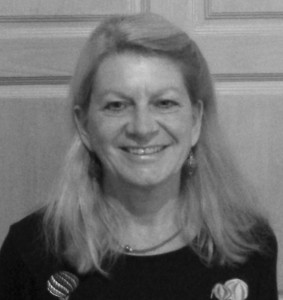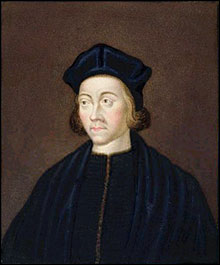14 April 2016
Bastards in the Church
A very brief historical perspective.
by Lynda Goetz
 The news this week of the true parentage of the Archbishop of Canterbury, Justin Welby, and his calm and gracious handling of these revelations has been the subject of a great deal of media coverage. Fortunately for him and for the Church, the unexpected information about his real father does not put him into the awkward position it would have done only a generation ago. Only in 1969 did the Church of England change its canon law to remove the ban on anyone who was born illegitimate becoming a bishop, let alone an archbishop.
The news this week of the true parentage of the Archbishop of Canterbury, Justin Welby, and his calm and gracious handling of these revelations has been the subject of a great deal of media coverage. Fortunately for him and for the Church, the unexpected information about his real father does not put him into the awkward position it would have done only a generation ago. Only in 1969 did the Church of England change its canon law to remove the ban on anyone who was born illegitimate becoming a bishop, let alone an archbishop.
Canon Law is a complex subject in its own right, but is generally defined as the body of rules and regulations made by an ecclesiastical authority for the governance of the church, essentially the Roman Catholic or Christian church. Until the Church of England under Henry VIII separated from the Roman Catholic Church, this country, like the rest of Europe, was subject to the rulings of the Pope and other regulations issuing from Rome. These were codified by Gratian in the mid-twelfth century and were not modernised until 1917, although many changes had taken place in the intervening centuries. The Church of England, likewise, was well behind the times and until 1969 still subject to canon law drawn up in the early 17th century and approved by James I. Geoffrey Fisher, Archbishop of Canterbury from 1945 to 1961, with the assistance of a Canon Law Commission which met eight times between 1943 and 1947, put a great deal of effort into updating, revising and rationalising the out-of-date law including, rather importantly, the prohibition against those who were illegitimate holding high office within the Church. Section C.2.4 now states that ‘No person shall be refused consecration on the grounds that he was born out of lawful wedlock’.
Had that change not been made, then this week’s revelations could have caused a constitutional crisis within the Church; although this may indeed have depended on interpretations of illegitimacy in ecclesiastical law. There are, it would seem, unresolved questions around what exactly constituted illegitimacy. Was a child illegitimate if, for example, a couple were married, but then some impediment to the marriage were discovered later? Common Law and Canon Law take different views on this one, with canon law, perhaps surprisingly, being the more indulgent. What would be the position of a woman impregnated by one man but who subsequently married another? According to Alan MacFarlane in his 2002 paper entitled ‘Illegitimacy and Illegitimates in English History’ it was apparently believed that the child was legitimate and must be accepted as his by the man who married the pregnant woman. (Other sources however say there was a rebuttable presumption that any child born to a married woman was legitimate, and as there was no DNA testing until recently, a rebuttal might have been somewhat easier). That situation precisely covers the case of Justin Welby, so perhaps even under the earlier canon law crisis might have been averted.
There is no doubt that the question of illegitimacy has long presented something of a problem to the Church, although it was common in the Middle Ages for illegitimate sons to reach high office within the Church. Perhaps one of the issues was that it rather depended on one’s social position and status as to whether legitimacy was a problem or not. Medieval kings and rulers were almost expected to have illegitimate or bastard children and generally, although of course these could not expect to succeed to the throne, they were usually provided with a title and estates.
William I (1066- 1087), often known as William the Conqueror or William the Bastard, was the son of the unmarried Robert I, Duke of Normandy and his mistress, Herleva. Herleva had another son, Odo, with Herluin de Conteville. Odo was for a long time William’s right-hand man and second in power after the king. He became the Duke of Kent, but was also an ordained cleric and Bishop of Bayeux. Illegitimacy seemed to carry little stigma amongst the warrior class of the day.
Henry I (1100-1135) fathered at least twenty-two illegitimate children, all of whom were publicly acknowledged and given titles and positions. Henry II (1154-1189) also acknowledged several bastards, one of whom, Geoffrey, was a more faithful son than any of his legitimate sons with Eleanor of Aquitaine. Geoffrey Plantagenet was born before Henry acceded to the throne and was raised with his father’s legitimate heirs. Henry decided on a career in the church for him and he was appointed firstly Archdeacon of Lincoln, then Bishop of Lincoln when only 21. He retained this position until 1181 when he relinquished it because of the Pope’s demand that his position be regularised by his becoming ordained, which he refused to do. His father then appointed him Chancellor of England, a position he renounced at the request of his half-brother, Richard, when he succeeded Henry. In order to comply with Henry’s dying wishes, however, Geoffrey was appointed Archbishop of York. On his deathbed, Henry is reputed to have said to Geoffrey, who was the only one of his sons to be with him in his final days, “You are my true son. The others, they are the bastards.”
Scottish kings prior to the Reformation were also renowned for giving high church office to their illegitimate sons. King James V of Scotland (1513-1542) had a favourite mistress, one Margaret Erskine, by whom he had a son, known as Lord James Stewart. Lord James was appointed Prior of St. Andrews when only seven years old. He held this position for many years although, like Henry II’s illegitimate son Geoffrey, he was never ordained. James V had a number of illegitimate offspring including (confusingly) another Lord James Stewart, an elder half-brother, who was also given a position in the church to become Abbot of Kelso. He died in 1557, however, whereas his younger sibling became a Protestant famously embroiled in the complex politics of the reign of his half-sister Mary, eventually becoming Regent when she was forced to abdicate in favour of her son, James VI.

University of Huddersfield historians Professor Tim Thornton and Dr Katherine Carlton produced a paper in 2012 entitled ‘Illegitimacy and Authority in the North of England 1450-1640’ in which, by analysing nearly 900 wills of the northern nobility and gentry, they uncovered a wealth of information about the treatment of illegitimate offspring– of which it appears there were quite a number. Their results showed that illegitimate children during this time did sometimes inherit property and ‘could achieve high office – with the church offering excellent career prospects’. A classic example was Cuthbert Tunstall, born in 1479, the eldest and illegitimate son of Thomas Tunstall of Thurland Castle, Lancashire. In spite of his illegitimacy he received a good education and went to Oxford, Cambridge and Padua Universities. On his return to England in 1506 he was granted a succession of increasingly elevated positions in the church and was presented at court. He became Master of the Rolls in 1516; in 1522 he was papally provided the bishopric of London; and he succeeded Wolsey as Bishop of Durham in 1529. He negotiated his way through Tudor politics to enjoy a long and successful career, during thirty-seven years of which he was a bishop, and died of old age in 1559.
Interestingly, if you type ‘Illegitimate Bishops’ into Google, what comes up repeatedly is a YouTube video of an American TV programme ‘The Lexi Show’ discussing the problem of the ease with which one can acquire the right to call oneself a bishop in America. Whilst the problem itself may be entirely different, the expression ‘Plus ҫa change….’ does somehow spring to mind.
Please click here if you would like a weekly email on publication of the Shaw Sheet

